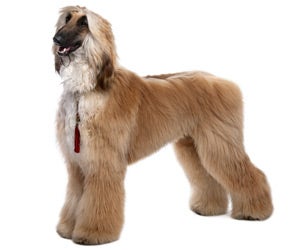Afghan Hound
-
Overview
View Grooming Diagram for afghan houndAfghan Hounds are large dogs with an elegant appearance. With his indifferent nature and majestic long coat he creates the image of an aristocratic dog, but underneath his dignified carriage, he can be wary of strangers and goofy with his owner. The Afghan Hound is the perfect dog for those who are not looking to lavish emotional attention on their pet, but would prefer to spend quality time exercising and grooming their more human-like companion. He will do best as a one-person dog because he is often intimidated by groups of people. He will appreciate the time and attention his companion commits to socializing and training him by becoming a devoted friend.
-
Personality
Afghans are free spirits, which means they will not constantly seek out your affection. They enjoy outdoor playtime, especially with others of their own kind. Afghans are such fast, graceful runners that their gait is often called a gallop. Although your dog will enjoy galloping about on his own outside, take care not to leave him to his own devices. These fierce hunters were originally bred to track down small, fast game, and their hunting instincts remain strong. If they are let out of fenced in areas, they will quickly disappear in pursuit of their prey. They have strong jaws and should be kept away from smaller house pets.
Because they have a mind of their own, Afghans are challenging to train. They have an especially difficult time with house training. Despite their air of indifference, these dogs are actually quite sensitive to criticism. They appreciate patience and understanding during the training process, even if it becomes challenging. Careful, respectful training and early socialization is important, because Afghans run the risk of becoming introverted and spookish.
Adult Afghans are not overly forthcoming with their affections. They can be spooked by loud noises or frequently changing environments. These dogs do best in homes where they can bond with one person and avoid excessive contact with strangers or children.
-
Coat Care
The Afghan's flowing coat makes him immediately recognizable. The long coat has a fine texture more similar to human hair than other dogs'. The coat parts in the middle of the dog's back and flows down his body, covering everything but the top of his back. When looking at an Afghan head-on, his hair and his "Roman" nose give his face an almost human-like appearance. Although this impressive coat is available in all colors, certain colors are preferred, especially in the show ring. It is most common to see Afghans in shades of honey and sandy brown, with darker markings along the face and ears. White colors are uncommon and discouraged.
The Afghan is known as the "king of dogs," and looking the part takes some hard work. Most owners find that their Afghans have an easier time eating and drinking while wearing a snood, which is a tube of fabric that covers the ears and neck.

Afghan Hounds should be brushed every day with an air-filled pin brush and a slicker brush to remove any mats or dead hair. The coat must be wet when it is brushed, because brushing a dry coat will damage and break the silky hair
Because Afghan Hounds have such finely-textured hair, their coats require at least monthly bathing to maintain the shine and texture.
Afghans have a soft, downy puppy coat that they will lose as their adult coat grows in. During this time, they will needed careful trimming and stripping to avoid mats and help the new coat grow in.
Many dog owners are apprehensive about trimming their dog’s nails because they are nervous about cutting into the quick. But with the right conditioning and careful cutting, nail clipping can be a simple, stress-free activity for you and your dog.
Provide your dog with plenty of positive reinforcement and even treats to help associate nail clipping with a positive experience. As you start to clip, gently press on your dog’s paws to help him become accustomed to the feeling of having his nails clipped. Then, work gradually, shaving down just a thin portion of the nail at first to make sure you don’t reach the quick. Clip one nail, reward your dog with a treat, and stop to give him some positive reinforcement before moving on. Gradually increase the number of nails you clip in one sitting to help your dog get used to the process. Never trim extremely long nails down to a short nail in one sitting, because this is an excellent way to accidently quick the dog’s nail. Instead, work gradually, shaving small portions of your dog’s nails off each time.
You can tell if you’re getting close to the quick by the texture of your dog’s nail. The nail is hard closer to the surface and becomes softer as you get closer to the quick. If your dog’s nail starts to feel softer, that’s a good indication that you’re getting close to the quick.
All dogs with hanging, pendant ears are prone to ear infections and should have their ears checked weekly for excess hair or infection. Trim around their ears and paws so their hair does not grow too long or painful.
Afghans have sensitive teeth that should be brushed about twice a week.

 India (English)
India (English)
 Middle East and Africa (English)
Middle East and Africa (English)
 South Africa (English)
South Africa (English)
 Australia (English)
Australia (English)
 Japan (日本語)
Japan (日本語)
 South East Asia (English)
South East Asia (English)
 Singapore (English)
Singapore (English)
 Europe (English)
Europe (English)
 United Kingdom (English)
United Kingdom (English)
 Argentina (Español)
Argentina (Español)
 Brazil (Portuguese)
Brazil (Portuguese)
 Colombia (Español)
Colombia (Español)
 Latin America (Español)
Latin America (Español)
 México (Español)
México (Español)
 Chile (Español)
Chile (Español)
 Peru (Español)
Peru (Español)
 Canada (English)
Canada (English)

